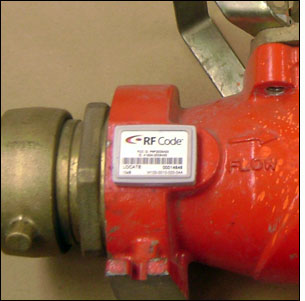Feb 10, 2010Alco Water Service, an investor-owned water utility based in Salinas, Calif., has rolled out an RFID-based system for both security and asset-management applications. The company, which maintains a number of unmanned pump stations throughout the town, is employing the system to gain better visibility into the use of its stations, both for operational efficiency and in compliance with the Bioterrorism Act, federal legislation passed in 2002.
The counterterrorism law requires that a water utility serving a population of 3,300 or more must assess its system's vulnerability to acts of terrorism or other intentional harm. Alco assessed the security of its unmanned well sites, each of which consists of a small building housing a pump, and secured with barbed-wire fencing. Based on that analysis, the firm decided that by issuing RFID tags to personnel then and linking those tags to an access-control system so that only authorized workers could enter the pumps stations, it would appreciably lower the stations' vulnerability to terrorist attack. The use of RFID would also allow Alco to maintain a detailed and accurate history of employee activity at each well.
In addition, the company determined that if it attached RFID tags to vital assets, its personnel would be better able to locate those assets quickly in the event of an emergency, which should also lower the vulnerability of the water system.
"Employees enter and leave our pump stations [throughout the day], and we have a lot of equipment, such as flow meters, that we need to track," says Adnen Chaabane, Alco Water's operations engineer. "We wanted to track what goes in and out of the stations, and at what times."
Alco worked with AssetPulse, an RFID systems integrator specializing in asset-tracking applications, to develop and launch the RFID system. The system consists of active RFID tags and readers from RF Code, which operate at 433 MHz and communicate via a proprietary air-interface protocol. The hardware is controlled using AssetGather, a software platform developed by AssetPulse. AssetGather is used to maintain a database that links each tag to a particular asset or employee, and also records a history of the times and locations of each tag read.
Chaabane says he was initially concerned that variable frequency drives inside the stations, which control the speed of the water pumps' electric motors, would generate RF interference with the RFID system. Upon testing, however, this proved not to be an issue, because these devices do not operate in the 433 MHz band.
The software is currently operating in a standalone status, but will soon be integrated into Alco's time-and-attendance software. While the company has no plans to use the RFID reads to determine each worker's pay, employees can use the tag-read history log to check times, such as how late they worked on a specific day, or when they arrived at a pump station or the maintenance shop.
Water systems are particularly vulnerable during power outages, so if electricity is lost at any facility or pump station, the interrogators deployed will switch to a battery-based, uninterruptible power supply for up to 30 minutes. Then, if the power is still out, a fuel-powered generator will kick in.
The system has been in place for 18 months, Chaabane says, having been rolled out permanently after being tested on a small scale for a few months. To date, he adds, Alco has spent approximately $100,000 for the entire system, though he estimates that the company has already seen a return on its investment through improved asset utilization, as well as by avoiding having to replace lost assets.
When searching for a particular asset, an employee can reference the AssetGather software to determine where and when that item was last detected by an RFID reader. This can save considerable time in hunting for the asset—especially when it eliminates the need to drive out to a remote pump station to search for it, or one like it. Because personnel spend less time looking for equipment, Chaabane notes, productivity has improved without any increase in labor spending. What's more, he says, Alco has saved money by virtue of no longer misplacing high-value assets and subsequently having to replace them.


